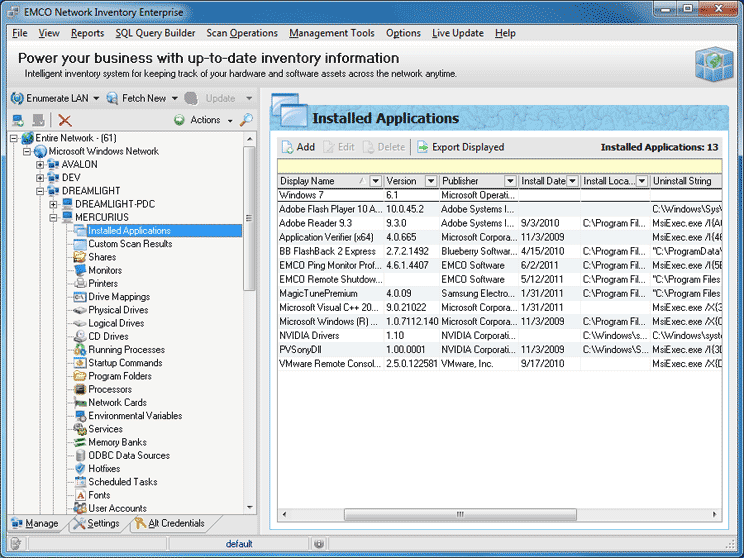PC Inventory Software for Remote PC Audit with no Client Installation
EMCO Network Inventory is a new generation of computer inventory management system that allows collecting PC inventory information remotely through local network, without attending of each desktop. This PC inventory software is able to work in domains and workgroups, including restricted subnets and has no any specific requirements for remote PCs. Using it, you don't need to tune Group Policy settings or install any client modules and enable WMI on remote PCs in order to collect software and hardware audit information from them in the automatic mode.
PC Inventory Software - Top Reasons to Choose EMCO Network Inventory
When you need to collect detailed PC inventory information for computers in your local network the only effective approach is to use automatic computer inventory system. Manual audit is very complicated and time-consuming if you would like to get detailed, quality inventory report. But automatic PC inventory software available on market isn't always a silver bullet. Most IT inventory software uses WMI services to receive audit information from remote PCs, but WMI is not always available because of OS or policy restrictions.
Other applications require remote client installation that creates additional headache for administrators and is pretty insecure. And most computer inventory systems fail to work in complex and restricted network environments consist of multiple domains and workgroups. To summarize, vast majority of PC inventory software unable to do their job because of different reasons. If you tried them, you definitely know about this.
EMCO Network Inventory is a product from the new PC inventory software generation, that doesn't use typical, but still ineffective approaches for remote PC inventory. Instead, it has a unique scan engine that can be used to extract audit data in very restrictive environments, so it can work where other tools fail. Would you like to try it to ensure? Download free evaluation version now.
Features and Benefits: Computer Inventory Management System
Unattended Remote PC Inventory
You can get detailed software and hardware inventory information about every PC in your local network by few mouse clicks without leaving your work place. All computer inventory operations for collecting audit information are executed remotely in the automatic mode without interruption of remote user's work.
Clientless Remote PC Audit
Collecting PC inventory information doesn't require installation of any client modules on remote computers or activating special services. Only general services, enabled by default in most environments, are required to collect PC inventory information remotely, so you don't need to configure remote desktops manually.
Large Networks Audit
It is possible to perform remote PC inventory in complex network structures that consist of multiple workgroups and domains. Computer inventory system can automatically enumerate all available workgroups and domains to extract list of PCs and collect audit information from particular PCs or PC groups.
Use Alternative Credentials
If your network contains multiple domains, workgroups or PCs with different administrative credentials, you can collect inventory information from all of them at one step during entire network scan if you define credentials that should be applied. You can configure credentials for particular PCs, workgroups and domains.
Fast Remote PC Inventory Scan
Remote scan for one computer and retrieving thousands hardware and software audit parameters takes just few seconds. Optimized scan engine allows scanning multiple remote PCs in parallel to increase inventory scan performance, so even for large networks you can get full audit report in just few minutes.
Inventory Scan by Stubs
Local PC inventory allows you to use a special stub application to execute inventory operation on local PC and prepare file with audit information for importing to the central database. It can be used to collect audit information from disconnected PCs and notebooks either manually or automatically by logon script during their login to the network.
